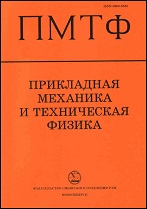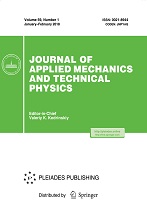|
|
Prikladnaya Mekhanika i Tekhnicheskaya Fizika, 2014, Volume 55, Issue 2, Pages 80–93
(Mi pmtf1082)
|
 |
|
 |
This article is cited in 7 scientific papers (total in 7 papers)
Linear stability of the Couette flow of a vibrationally excited gas. 1. Inviscid problem
Yu. N. Grigor'eva, I. V. Ershovb
a Institute of Computational Technologies, Siberian Branch of the Russian Academy of Sciences, Novosibirsk, 630090, Russia
b Novosibirsk State University of Architecture and Civil Engineering, Novosibirsk, 630008, Russia
Abstract:
Stability of the Couette flow of a vibrationally excited diatomic gas with a parabolic profile of static temperature is studied within the framework of the linear theory. A set of explicit asymptotic estimates are obtained for inviscid disturbances described by a system of linearized equations of two-temperature gas dynamics. It is shown that the first Rayleigh condition (theorem) is satisfied for unstable modes, and the classification of inviscid modes into even and odd modes is valid. A generalized condition of the presence of an inflection point on the velocity profile, which is necessary for disturbances to evolve, is obtained. The sufficient condition in Howard's semi-circle theorem is refined. Complex phase velocities of two-dimensional even and odd inviscid modes are numerically calculated as functions of the Mach number, degree of excitation of vibrational levels of energy, and characteristic relaxation time. In the Couette flow problem, in contrast to the case of a free shear layer, the growth rate of the most unstable second mode increases with increasing Mach number and tends to a certain limit for which an asymptotic expression in the form of an ordinary differential equation is obtained. The calculated results show that the effect of reduction of the growth rate on the background of the relaxation process is clearly expressed in the range of flow parameters considered.
Keywords:
linear stability theory, vibrational relaxation, equations of two-temperature aerodynamics, inviscid modes of disturbances.
Received: 24.05.2013
Citation:
Yu. N. Grigor'ev, I. V. Ershov, “Linear stability of the Couette flow of a vibrationally excited gas. 1. Inviscid problem”, Prikl. Mekh. Tekh. Fiz., 55:2 (2014), 80–93; J. Appl. Mech. Tech. Phys., 55:2 (2014), 258–269
Linking options:
https://www.mathnet.ru/eng/pmtf1082 https://www.mathnet.ru/eng/pmtf/v55/i2/p80
|


|





 Contact us:
Contact us: Terms of Use
Terms of Use
 Registration to the website
Registration to the website Logotypes
Logotypes








 Citation in format
Citation in format 
